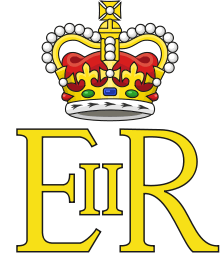Great Seal of Canada
The Great Seal of Canada (French: Grand Sceau du Canada) is a governmental seal used for purposes of state in Canada, being set on letters patent, proclamations[1] and commissions, both to representatives of the Queen and for the appointment of cabinet ministers, senators, and judges.[2][3] Many other officials, such as officers in the Canadian Armed Forces, receive commissions affixed with the Privy Seal, not the great seal.[3] It is not for sealing up a document as letters close.
The great seal's design is changed soon after the accession of a new sovereign and is considered by the Department of Canadian Heritage to be one of the official symbols of Canada.[4]
History
The first Great Seal of Canada was carved in The United Kingdom and sent to Canada to replace a temporary seal which had been used since Confederation in 1867. On the great seal assigned to Canada in 1869, the arms of each of the original provinces—Nova Scotia, New Brunswick, Québec, and Ontario—were shown separately, two on each side of the figure of Queen Victoria seated beneath a canopy.[5]
In view of the intended tour of Canada by George VI in 1939 as king of Canada, the federal parliament passed an act to let the Great Seal of Canada be used for functions that were, at that time, normally carried out by the King in London using the Great Seal of the United Kingdom—such as the issuing of an instrument of ratification for an international treaty—but were to be performed by the King while in Canada. This event, symbolizing Canadian independence and continuing loyalty to the Crown, was described by the tour's official historian as establishing a new official procedure "which asserted and recognized Canada's equality of political status within the British Empire."[6]
Appearance
Dies (seal-making devices) for old seals are destroyed whenever a new monarch takes the throne. The current great seal was designed by artist Eric Aldwinckle and made at the Royal Canadian Mint when Queen Elizabeth II succeeded her father in 1952 and it went into use on 14 November 1955.[7] The seal die is made of specially tempered steel, weighs 3.75 kilograms (8.27 pounds), and is 127 millimetres (5 inches) in diameter. The image depicts the Queen enthroned on the coronation chair and robed, holding the orb and sceptre, and the 1957 version of the Royal Arms of Canada in front. Around the perimeter is inscribed REINE DU CANADA—ELIZABETH II—QUEEN OF CANADA. Previous Great Seals of Canada were inscribed in Latin. While the governor general is the keeper of the Great Seal, the Queen's representative places it in the protection of the Registrar General of Canada. Each of the provinces has its own unique great seal for similar purposes, which is used by the lieutenant governor of the province and kept by the provincial attorney general.
- Images of the Great Seal of Canada
 The first Great Seal of Canada, depicting Queen Victoria, embedded in a sculpture in Major's Hill Park, Ottawa
The first Great Seal of Canada, depicting Queen Victoria, embedded in a sculpture in Major's Hill Park, Ottawa The present great seal, for Queen Elizabeth II, used since 1955
The present great seal, for Queen Elizabeth II, used since 1955.jpg) The royal proclamation of the flag of Canada, bearing an impression of the great seal at lower left[8]
The royal proclamation of the flag of Canada, bearing an impression of the great seal at lower left[8] Rendition of the royal arms of Canada depicted in miniature on the 1955 version of the seal
Rendition of the royal arms of Canada depicted in miniature on the 1955 version of the seal
Legal status
Like the Great Seal of the United Kingdom in respect of the Crown of that country, the Great Seal of Canada is the chief seal of the Crown of Canada, and is used to show the Canadian monarch's approval of important state documents. The sovereign acts on the advice of the government of the day.[9] However, unlike Canada, use of the Privy Seal was abolished in the United Kingdom after the passing of the Great Seal Act 1884.[10]
The Canadian Great Seal is used not only for administrative purposes, but also ceremonially, when it is put into the custody of a new governor general as part of the customary swearing-in and installation procedure.[11] It is protected under the Security of Information Act, Section 5(2)(e) stating: "Every person who, without lawful authority or excuse, manufactures or sells, or has in his possession for sale, any die, seal or stamp referred to in subsection (1) is guilty of an indictable offence and liable to imprisonment for a term of not more than 14 years or by summary conviction and liable to imprisonment for a term of not more than 12 months or to a fine of not more than $2,000."[12]
See also
References
- ↑ Library and Archives Canada. "Proclamation of the Constitution Act 1982". Image of original proclamation. Queen's Printer for Canada. Retrieved 27 March 2012.
- ↑ The Great Seal of Canada
- 1 2 Her Majesty the Queen in Right of Canada (2012). "Consolidation - Formal Documents Regulations" (PDF).
- ↑ Government of Canada (3 February 2013). "Official symbols of Canada". Queen's Printer for Canada. Retrieved 16 December 2015.
- ↑ Emblems of Canada
- ↑ Fiftieth Anniversary of the 1939 Royal Visit, J. William Galbraith, as an information Officer with the federal government.
- ↑ http://www.thecanadianencyclopedia.ca/en/article/great-seal-of-canada/
- ↑ Royal Proclamation on Parliament Hill
- ↑ Great seal of the realm
- ↑ Great Seal Act 1884
- ↑ The Great Seal of Canada
- ↑ Security of Information Act
External links
- Canadian Heritage: The Great Seal of Canada
- Governor General of Canada: The Great Seal of Canada (archived)
- Governor General's Installation (5), Ceremonial delivery of the Great Seal, at 1.15-2.40 mins
